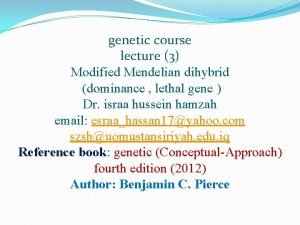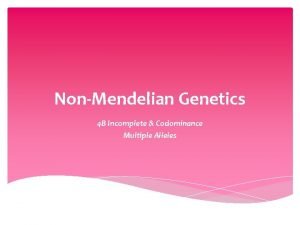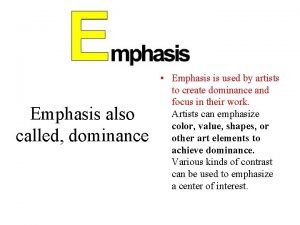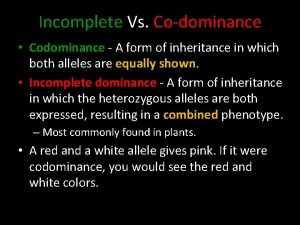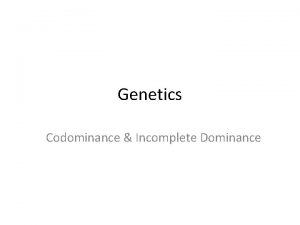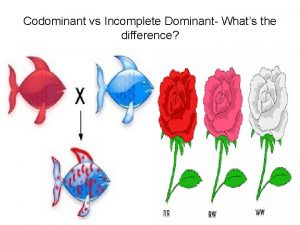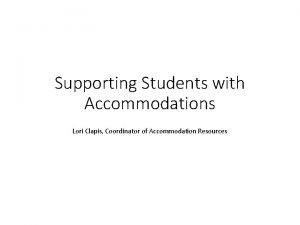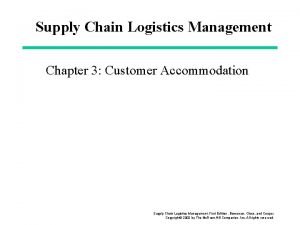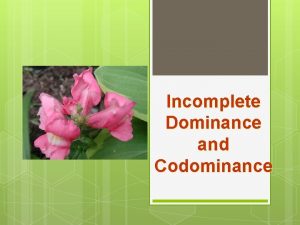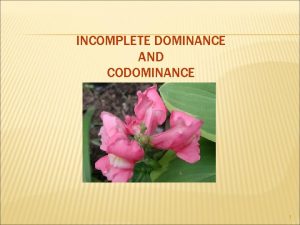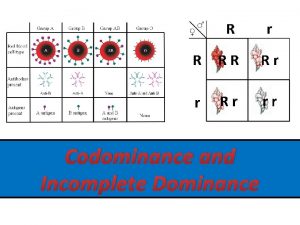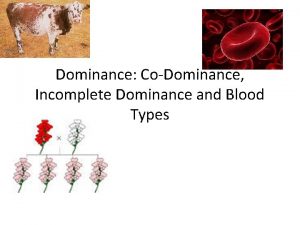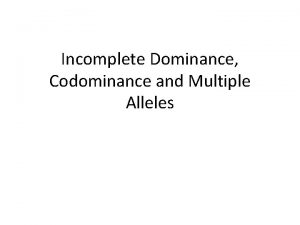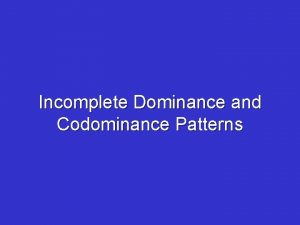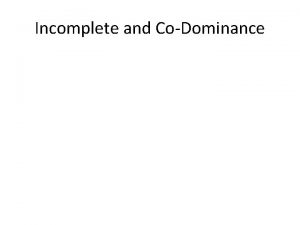IMPACT OF DOMINANCE AND NURTURANCE ON ACCOMMODATION IN


















- Slides: 18

IMPACT OF DOMINANCE AND NURTURANCE ON ACCOMMODATION IN HETEROSEXUAL RELATIONSHIPS Stanley O. Gaines, Jr. Brunel University London & Deletha P. Hardin The University of Tampa… 24/07/2016 Dr. Stanley O. Gaines, Jr. 1

…with Zeeshan Aslam Dominique Cameron-Quest Danielle Clahar-Raymond Kelly Dieu Winifred Appiah Frimpong Sophia Gordon Hana Jiryes-Johnson Marya Karimzada Zuzanna Krzemien Joshua Maguire Ahlam Malfouz Saira Mohammad Sara Nasir Terasa O’Halloran Ilana Sichel Roshana Wickremaratchi Abigail Williams Abigail Wright Binnur Yildirim Brunel University London 24/07/2016 Dr. Stanley O. Gaines, Jr. 2

INTRODUCTION: HARRY STACK SULLIVAN’S INTERPERSONAL THEORY OF PERSONALITY • Harry Stack Sullivan’s interpersonal theory: personality is the "relatively enduring pattern of recurrent interpersonal situations which characterize a human life“ (1953, p. 111). • Leary (1957): interpersonal theory suggests that certain traits are especially likely to be reflected in individuals’ behavior toward relationship partners. 24/07/2016 Dr. Stanley O. Gaines, Jr. 3

24/07/2016 Dr. Stanley O. Gaines, Jr. 4

DOMINANCE AND NURTURANCE AS TWO MAJOR INTERPERSONAL TRAITS • Wiggins (1979): conceptually, and demonstrated empirically, dominance (i. e. , individuals’ tendency to behave in ways that benefit themselves) and nurturance (i. e. , individuals’ tendency to behave in ways that benefit persons other than, or in addition to, themselves) are two major interpersonal traits. 24/07/2016 Dr. Stanley O. Gaines, Jr. 5

CLEAR HYPOTHESIS REGARDING NURTURANCE AS A SIGNIFICANT POSITIVE PREDICTOR OF ACCOMMODATION • Kelley (1983): nurturance is a trait that promotes “commonality of interest” (p. 16) between individuals and their partners. 24/07/2016 Dr. Stanley O. Gaines, Jr. 6

CLEAR HYPOTHESIS REGARDING NURTURANCE AS A SIGNIFICANT POSITIVE PREDICTOR OF ACCOMMODATION • Hypothesis: nurturance would be a significant positive predictor of accommodation (i. e. , individuals’ response to partners’ anger/criticism with relationshipmaintaining, not relationship-threatening, behavior; see Rusbult et al. , 1991). 24/07/2016 Dr. Stanley O. Gaines, Jr. 7

RESEARCH QUESTION REGARDING DOMINANCE AS A PREDICTOR OF ACCOMMODATION • Kelley (1983): dominance is a trait that “shift[s] the control from… joint to individual control” (p. 17), such that individuals gain control over their partners. • Individual control can cut both ways in terms of accommodation, promoting “threats” as well as “promises. ” 24/07/2016 Dr. Stanley O. Gaines, Jr. 8

RESEARCH QUESTION REGARDING DOMINANCE AS A PREDICTOR OF ACCOMMODATION • Research question: How, if at all, does dominance affect accommodation? 24/07/2016 Dr. Stanley O. Gaines, Jr. 9

METHOD: PARTICIPANTS Sample 1 • 323 individuals • 124 men, 192 women, seven individuals who did not report their gender • Average = 23. 17 years (SD = 7. 70) • 51. 1% were of European descent • [final N = 289] 24/07/2016 Sample 2 • 448 individuals • 155 men, 284 women, nine individuals who did not report their gender • Average = 28. 92 years (SD = 13. 08) • 51. 3% were of European descent • [final N = 372] Dr. Stanley O. Gaines, Jr. 10

METHOD: MATERIALS In both samples, participants completed: • 32 -item International Personality Item Pool. Interpersonal Circle (IPIP-IPC; Markey & Markey, 2009) – measure the interpersonal traits of dominance and nurturance – reliabilities for the eight 4 -item subscales generally were. 60 or higher. • 12 -item accommodation inventory (Rusbult et al. , 1991) – reliabilities for the four 3 -item subscales consistently were 24/07/2016. 60 or higher. Dr. Stanley O. Gaines, Jr. 11

METHOD: PROCEDURE • Prior to conducting the present study, the first author obtained ethics approval from the Psychology Ethics Committee within the first author’s academic institution. • Participants were recruited within the greater London area; both samples constituted convenience samples. • Participation was voluntary; no financial or other incentives were offered to participants. 24/07/2016 Dr. Stanley O. Gaines, Jr. 12

RESULTS: HYPOTHESIS SUPPORTED REGARDING NURTURANCE AS SIGNIFICANT POSITIVE PREDICTOR OF ACCOMMODATION • Results of structural equation analyses (using LISREL; Joreskog & Sorbom, 2012) indicated that, in both samples, the higher-order dimension of nurturance was a significant positive predictor of the higherorder dimension of accommodation. • Hypothesis regarding nurturance was supported. 24/07/2016 Dr. Stanley O. Gaines, Jr. 13

24/07/2016 14

RESULTS: RESEARCH QUESTION ANSWERED REGARDING DOMINANCE AS INCONSISTENTLY RELATTED TO ACCOMMODATION • Results of structural equation analyses also indicated that, in Sample 2 only, the higher-order dimension of dominance was a significant negative predictor of the higher-order dimension of accommodation. • [In Sample 1, the effect of dominance on accommodation was near zero. ] 24/07/2016 Dr. Stanley O. Gaines, Jr. 15

24/07/2016 16

CONCLUSION: INTERPERSONAL TRAITS AS RELEVANT TO UNDERSTANDING A MAJOR INTERDEPENDENCE PROCESS • Interpersonal traits of dominance and nurturance, derived from interpersonal theory (Sullivan, 1953), are relevant to understanding a major interdependence process from the standpoint of interdependence theory (Kelley, 1979; Kelley & Thibaut, 1978; Thibaut & Kelley, 1959) – namely, accommodation. 24/07/2016 Dr. Stanley O. Gaines, Jr. 17

THANKS! 24/07/2016 Dr. Stanley O. Gaines, Jr. 18
 The family is a social institution that is found in
The family is a social institution that is found in What is nurturance
What is nurturance Acculturation model and accommodation theory of sla
Acculturation model and accommodation theory of sla Fla vs sla
Fla vs sla Divergence excess
Divergence excess Animal accommodation fixtures and fittings
Animal accommodation fixtures and fittings The difference between dominance and codominance
The difference between dominance and codominance Standards battles and design dominance
Standards battles and design dominance Standards battles and design dominance
Standards battles and design dominance What does incomplete dominance mean
What does incomplete dominance mean Types of dominance in art
Types of dominance in art Low dominance and low sociability
Low dominance and low sociability Difference between complete and incomplete dominance
Difference between complete and incomplete dominance What does incomplete dominance mean
What does incomplete dominance mean Example of codominance
Example of codominance Codominance vs incomplete dominance
Codominance vs incomplete dominance Eye phy
Eye phy Accommodation letter for student
Accommodation letter for student What is the developing customer accommodation strategy?
What is the developing customer accommodation strategy?






